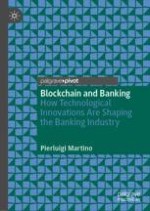2021 | OriginalPaper | Buchkapitel
5. Regulation of Blockchain Technology: An Overview
verfasst von : Pierluigi Martino
Erschienen in: Blockchain and Banking
Aktivieren Sie unsere intelligente Suche, um passende Fachinhalte oder Patente zu finden.
Wählen Sie Textabschnitte aus um mit Künstlicher Intelligenz passenden Patente zu finden. powered by
Markieren Sie Textabschnitte, um KI-gestützt weitere passende Inhalte zu finden. powered by
